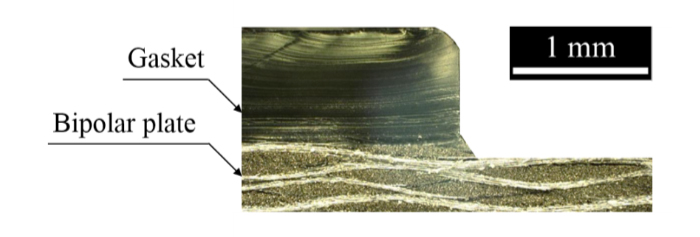Fuel cells consist of many components including end plates, bipolar plates, membranes, gas diffusion layers, and gaskets. Among these components, the bipolar plates account for approximately 38% of the stack cost because they make up more than 80% of the stack weight and volume, induce high stack assembly costs, and require long assembly times. In addition to the bipolar plates, the gasket is also an important component of proton exchange membrane fuel cells (PEMFCs) because it prevents fuel leakage. The sealing of the PEMFC stack is crucial because it can affect the efficiency, reliability, and maintenance costs. During the assembly of PEMFC stacks, elastomer gaskets, which are usually made with silicone, are installed for sealing the stacks. Conventional PEMFCs require numerous elastomer gaskets to seal the stacks, which increases the manufacturing and assembly costs.
Dongyoung Lee, a Ph.D. candidate in the Mechanical Engineering Department at KAIST under Professor Dai Gil Lee, recently developed a gasket-integrated carbon/silicone composite bipolar plate which can eventually eliminate the need for additional gaskets. He fabricated the bipolar plate using an elastomeric matrix rather than a conventional epoxy matrix. Because the matrix of the bipolar plate was identical to the gasket material, the gasket could be integrated with the bipolar plate. This new technology will greatly reduce the assembly time and sealability of the PEMFC which will lead to widespread use of the fuel cells.

For this breakthrough Dongyoung Lee received the Best Paper Award at the 18th International Conference on Composite Structures (ICCS) which was held in Lisbon, Portugal, from June 15 to 18, 2015. The ICCS is held every other year, and is one of the largest and longest-running conferences on composite materials and structures in the world. At this year’s conference, a total of 680 papers were presented, among which, two papers were chosen for the Best Paper Award, including Mr. Lee’s. This work will be published under the title: “Gasket-integrated Carbon/Silicone Elastomer Composite Bipolar Plate for High-temperature PEMFC” in the September issue of Composite Structures, which is one of top journals in mechanical engineering as judged by the Google Scholar Metrics rankings.
Mr. Lee said, “I would like to thank many people who supported me, especially my advisor, Professor Dai Gil Lee, who encouraged me to innovate continuously. Without his guidance and encouragement, I would have not won this award. I hope to contribute to solving energy problems in the future.” Professor Jun Woo Lim from Chonbuk National University, Senior Researcher Ilbeom Choi from the Agency for Defense Development, and fellow Ph.D candidate Soohyun Nam from KAIST participated in this research.







